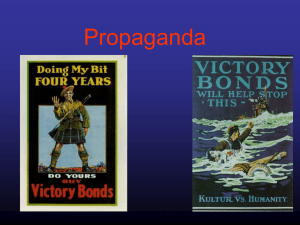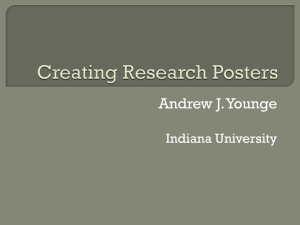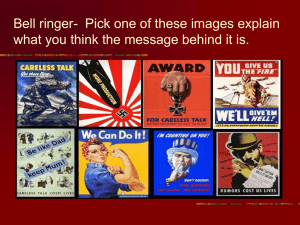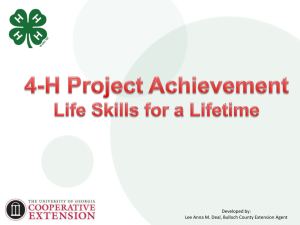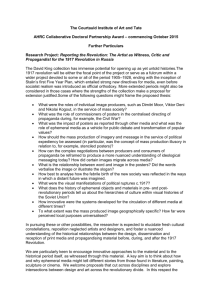Critical Inquiry of Propaganda Posters from World War I
advertisement
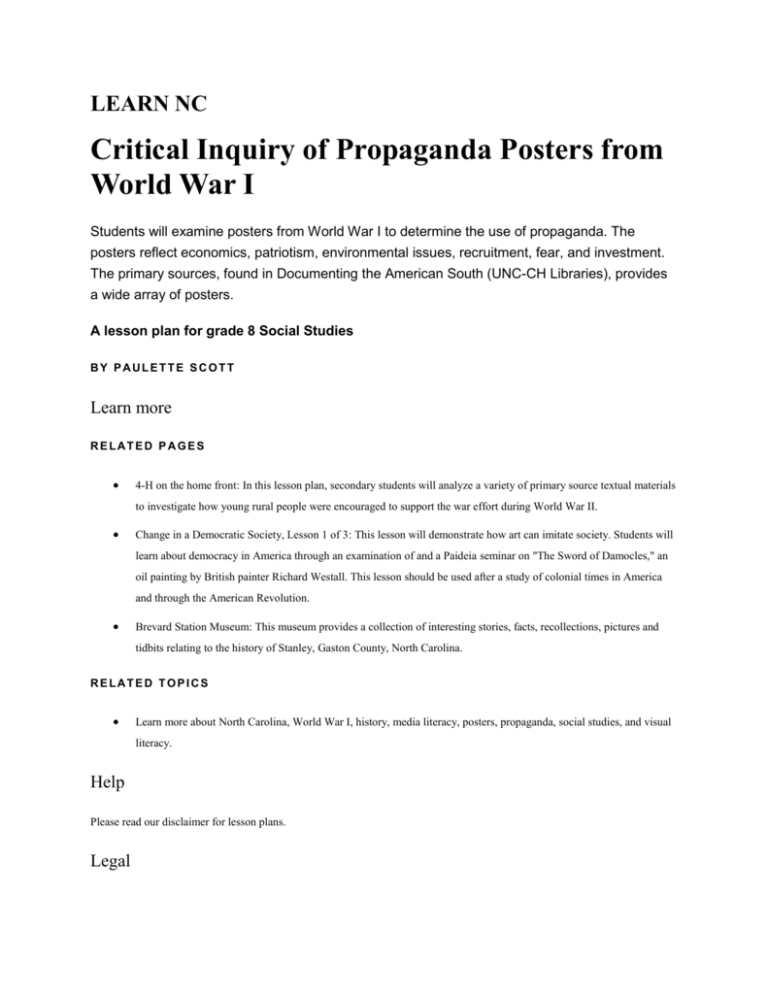
LEARN NC Critical Inquiry of Propaganda Posters from World War I Students will examine posters from World War I to determine the use of propaganda. The posters reflect economics, patriotism, environmental issues, recruitment, fear, and investment. The primary sources, found in Documenting the American South (UNC-CH Libraries), provides a wide array of posters. A lesson plan for grade 8 Social Studies BY PAULETTE SCOTT Learn more RELATED PAGES 4-H on the home front: In this lesson plan, secondary students will analyze a variety of primary source textual materials to investigate how young rural people were encouraged to support the war effort during World War II. Change in a Democratic Society, Lesson 1 of 3: This lesson will demonstrate how art can imitate society. Students will learn about democracy in America through an examination of and a Paideia seminar on "The Sword of Damocles," an oil painting by British painter Richard Westall. This lesson should be used after a study of colonial times in America and through the American Revolution. Brevard Station Museum: This museum provides a collection of interesting stories, facts, recollections, pictures and tidbits relating to the history of Stanley, Gaston County, North Carolina. RELATED TOPICS Learn more about North Carolina, World War I, history, media literacy, posters, propaganda, social studies, and visual literacy. Help Please read our disclaimer for lesson plans. Legal This page copyright ©2008. Terms of use Learning outcomes Students should learn that posters do not always carry a simple message, but can be subtle and aggressive. Students should realize that governments use posters in varying ways. This lesson also helps with student literacy and enhances their ability use a critical eye. Teacher planning TIM E REQUIRED FOR LESSON 1 day M AT E R I AL S / R E S O U R C E S Teacher-made template in order for students to complete chart Articles from the TAR HEEL JUNIOR HISTORIAN “Introduction: NC in WWI” by R. Jackson Marshall p.1-2 “The Approaching War” by Sarah McColloh Lemmon p.3-5 “Support from the Home Front” by Richard L. Zuber p.9-13 “Thousands of Miles from Home” by John Lee Bumgarner p.16-17 Images - Propaganda posters from Documenting the American South TECHNOLOGY RESOURCES Internet access, computer lab Pre-activities Students will have needed to study the causes of WW I Students will need to know why the US became involved in this global war Activities 1. Students will read articles from the TAR HEEL JUNIOR HISTORIAN related to WW I 2. Teachers will brainstorm with students the definitions of propaganda and how it has been used historically; students should be able to distinguish different types of propaganda. 3. The teacher will give instructions as to how the chart should be completed. 4. The teacher will explain how to use the Docsouth website and exactly how to get to posters. 5. Students will select five posters from the website. Each poster should reflect a different slant (environmental,economic,patriotism,etc.)Students will use information and inference to fill in the chart (I recommend using a block schedule or use two days to complete the lesson) 6. Students should then be asked to share findings with the class Assessment The chart will be used as assessment determining whether or not students grasped an understanding of the concepts reflected in each selected poster Supplemental information Refer to textbook for understanding of the causes of WW I Posters can be enlarged for better detail NC Museum of History (for Tar Heel Junior Historian) R E L AT E D W E B S I T E S “Propaganda Posters” Created by Libby Chenault http://docsouth.unc.edu/wwi/posters.html COMMENTS Less focus has been placed on this significant global war in the middle level grades. Study of the times also gives basic information as to causes of WW II. Documenting the American South has a wealth of resources related to WW I. Students who are war buffs will be fascinated. Students could also work in pairs, especially if technnology is lmited at your school. North Carolina Curriculum Alignment S O C I AL S T U D I E S ( 2 0 0 3 ) Grade 8 Goal 5: The learner will evaluate the impact of political, economic, social, and technological changes on life in North Carolina from 1870 to 1930. o Objective 5.04: Identify technological advances, and evaluate their influence on the quality of life in North Carolina. o Objective 5.05: Assess the influence of the political, legal, and social movements on the political system and life in North Carolina. LEARN NC, a program of the University of North Carolina at Chapel Hill School of Education, finds the most innovative and successful practices in K–12 education and makes them available to the teachers and students of North Carolina — and the world. For more great resources for K–12 teaching and learning, visit us on the web at www.learnnc.org.

